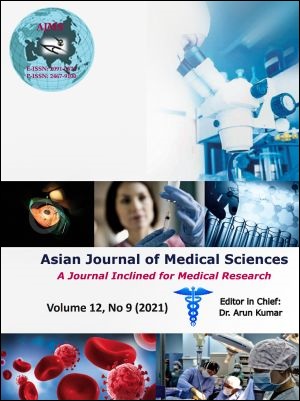Outcome of ventilation in patients with hypercapnic respiratory failure in IPF patients: A prospective study
Keywords:
Adolescent, Artificial respiration, Bronchodilator agents, Idiopathic pulmonary fibrosis, Interstitial lung diseases, Noninvasive ventilation, Respiratory insufficiencyAbstract
Background: Diffuse parenchymal lung disease (DPLD) is the inflammation and fibrosis of lung interstitium, resulting in respiratory failure. The rate of hypoxic respiratory failure is high as the disease progresses. In idiopathic pulmonary fibrosis (IPF) patients, acute deterioration leads to type 2 respiratory failure, etiology and management of which remains to be completely understood.
Aims and Objectives: To identify the causes of type 2 respiratory failure and assess the outcome of invasive and non-invasive ventilation in patients with IPF.
Materials and Methods: This prospective single center study included >18-year-old 44 patients with IPF. History of patients, complete blood count, chest radiograph, urine routine, spirometry with bronchodilator reversibility, DLCO (diffusing capacity for carbon monoxide) testing, arterial blood gas measurements, and antinuclear antibody (ANA) test were evaluated.
Results: Fourteen (31.8%) patients developed type 2 respiratory failure (within 1.5–6 years from the time of onset of illness). Causes of respiratory failure included acute exacerbation of IPF (35.71%), infections (14.29%), heart failure (14.29%), ischemic heart disease (14.29%), pulmonary embolism (21.43%), pneumothorax (7.14%), and surgical lung biopsy (7.14%). Patients were initiated on non-invasive mechanical ventilation (NIV) (64.29%) and invasive mechanical ventilation (IMV) (35.71%). Eight (88.89%) out of 9 patients on NIV survived, whereas all 5 patients (100%) on IMV expired.
Conclusion: Considering the higher mortality rate associated with IMV, NIV is a better technique than IMV for improving patient outcome and management. NIV may be effectively implemented for improving the treatment outcome in patients with IPF and avoiding any aggressive therapeutic approaches.
Downloads
Downloads
Published
How to Cite
Issue
Section
License
Copyright (c) 2021 Asian Journal of Medical Sciences

This work is licensed under a Creative Commons Attribution-NonCommercial 4.0 International License.
Authors who publish with this journal agree to the following terms:
- The journal holds copyright and publishes the work under a Creative Commons CC-BY-NC license that permits use, distribution and reprduction in any medium, provided the original work is properly cited and is not used for commercial purposes. The journal should be recognised as the original publisher of this work.
- Authors are able to enter into separate, additional contractual arrangements for the non-exclusive distribution of the journal's published version of the work (e.g., post it to an institutional repository or publish it in a book), with an acknowledgement of its initial publication in this journal.
- Authors are permitted and encouraged to post their work online (e.g., in institutional repositories or on their website) prior to and during the submission process, as it can lead to productive exchanges, as well as earlier and greater citation of published work (See The Effect of Open Access).




